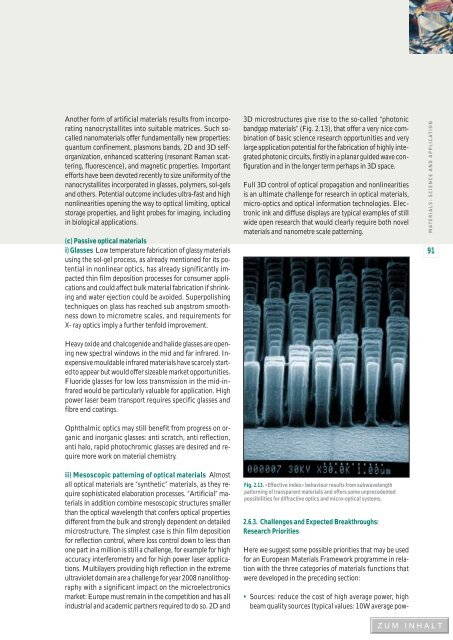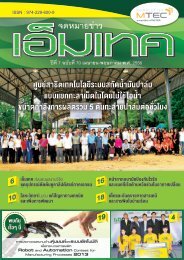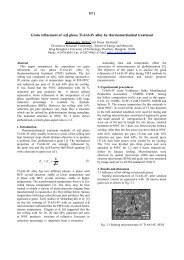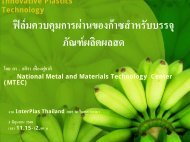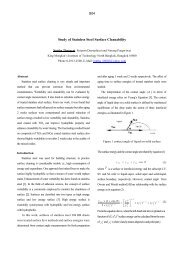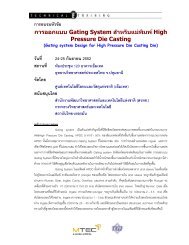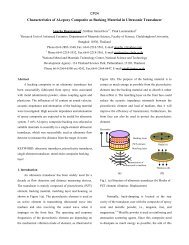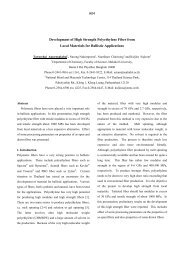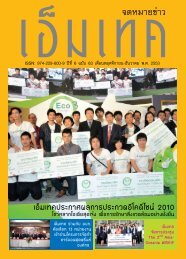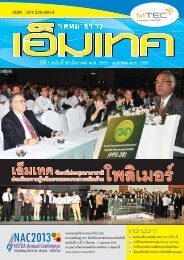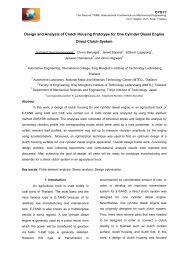EUROPEAN WHITE BOOK
EUROPEAN WHITE BOOK
EUROPEAN WHITE BOOK
Create successful ePaper yourself
Turn your PDF publications into a flip-book with our unique Google optimized e-Paper software.
Another form of artificial materials results from incorporatingnanocrystallites into suitable matrices. Such socallednanomaterials offer fundamentally new properties:quantum confinement, plasmons bands, 2D and 3D selforganization,enhanced scattering (resonant Raman scattering,fluorescence), and magnetic properties. Importantefforts have been devoted recently to size uniformity of thenanocrystallites incorporated in glasses, polymers, sol-gelsand others. Potential outcome includes ultra-fast and highnonlinearities opening the way to optical limiting, opticalstorage properties, and light probes for imaging, includingin biological applications.(c) Passive optical materialsi) Glasses Low temperature fabrication of glassy materialsusing the sol-gel process, as already mentioned for its potentialin nonlinear optics, has already significantly impactedthin film deposition processes for consumer applicationsand could affect bulk material fabrication if shrinkingand water ejection could be avoided. Superpolishingtechniques on glass has reached sub angstrom smoothnessdown to micrometre scales, and requirements forX- ray optics imply a further tenfold improvement.3D microstructures give rise to the so-called “photonicbandgap materials” (Fig. 2.13), that offer a very nice combinationof basic science research opportunities and verylarge application potential for the fabrication of highly integratedphotonic circuits, firstly in a planar guided wave configurationand in the longer term perhaps in 3D space.Full 3D control of optical propagation and nonlinearitiesis an ultimate challenge for research in optical materials,micro-optics and optical information technologies. Electronicink and diffuse displays are typical examples of stillwide open research that would clearly require both novelmaterials and nanometre scale patterning.MATERIALS: SCIENCE AND APPLICATION91Heavy oxide and chalcogenide and halide glasses are openingnew spectral windows in the mid and far infrared. Inexpensivemouldable infrared materials have scarcely startedto appear but would offer sizeable market opportunities.Fluoride glasses for low loss transmission in the mid-infraredwould be particularly valuable for application. Highpower laser beam transport requires specific glasses andfibre end coatings.Ophthalmic optics may still benefit from progress on organicand inorganic glasses: anti scratch, anti reflection,anti halo, rapid photochromic glasses are desired and requiremore work on material chemistry.ii) Mesoscopic patterning of optical materials Almostall optical materials are “synthetic” materials, as they requiresophisticated elaboration processes. “Artificial” materialsin addition combine mesoscopic structures smallerthan the optical wavelength that confers optical propertiesdifferent from the bulk and strongly dependent on detailedmicrostructure. The simplest case is thin film depositionfor reflection control, where loss control down to less thanone part in a million is still a challenge, for example for highaccuracy interferometry and for high power laser applications.Multilayers providing high reflection in the extremeultraviolet domain are a challenge for year 2008 nanolithographywith a significant impact on the microelectronicsmarket: Europe must remain in the competition and has allindustrial and academic partners required to do so. 2D andFig. 2.13. «Effective index» behaviour results from subwavelengthpatterning of transparent materials and offers some unprecedentedpossibilities for diffractive optics and micro-optical systems.2.6.3. Challenges and Expected Breakthroughs:Research PrioritiesHere we suggest some possible priorities that may be usedfor an European Materials Framework programme in relationwith the three categories of materials functions thatwere developed in the preceding section:• Sources: reduce the cost of high average power, highbeam quality sources (typical values: 10W average pow-


